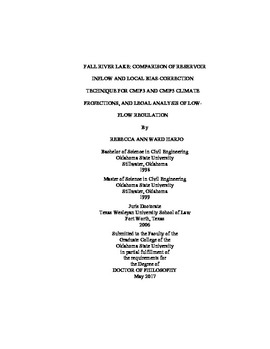| dc.contributor.advisor | Brown, Glenn | |
| dc.contributor.author | Harjo, Rebecca Ann Ward | |
| dc.date.accessioned | 2018-03-13T18:15:44Z | |
| dc.date.available | 2018-03-13T18:15:44Z | |
| dc.date.issued | 2017-05 | |
| dc.identifier.uri | https://hdl.handle.net/11244/54535 | |
| dc.description.abstract | Scope and Method of Study: This case study compares the World Climate Research Programme's (WCRP's) Coupled Model Intercomparison Project phase 5 (CMIP5) against the phase 3 (CMIP3) guidance for a case study location of Fall River Lake in Kansas. A new method of locally calibrating reservoir inflow climate-change ensembles using monthly factors derived by averaging correction factors calculated from a range of exceedance values was proposed and compared against calibrating only the mean and median of the ensemble. Federal agency reservoir operations and statutory, regulatory, and compact legal provisions affecting Verdigris Basin in Kansas were also analyzed. | |
| dc.description.abstract | Reservoir inflow from CMIP3 and CMIP5 climate-change ensembles was compared against each other and observations. CMIP5 inflows were generally lower than CMIP3 and both had wet biases for low flows and dry for high flows. CMIP3 projections are the recommended generation of climate-change model projections that should be used for current climate-change studies for this reservoir as the ensemble mean of the CMIP3 projections from the hydrology dataset came closer to reproducing the monthly mean from observations. | |
| dc.description.abstract | A new method of calibrating monthly correction factors based on averaging local bias-correction factors for the 5, 10, 25, 50, 75, 90, and 95% exceedance probabilities resulted in higher the flows in summer than calibrating using a local bias-correction factor developed from only the 50% exceedance or ensemble mean values. This new approach provides for a more flexible methodology to accommodate areas with highly skewed hydrologic patterns like typical low streamflows with occasional or rare extreme flows. Other reservoirs with similar highly skewed hydrologic patterns could also benefit. | |
| dc.description.abstract | It is recommended that Kansas State statutes and U.S. Army Corps of Engineers regulations regarding low-flow control in the entire Verdigris Basin be consolidated to minimize potential conflicts. Inviting the Cherokee and Osage tribes to be partners in the Kansas-Oklahoma Arkansas River Compact discussions would also minimize potential legal issues. | |
| dc.format | application/pdf | |
| dc.language | en_US | |
| dc.rights | Copyright is held by the author who has granted the Oklahoma State University Library the non-exclusive right to share this material in its institutional repository. Contact Digital Library Services at lib-dls@okstate.edu or 405-744-9161 for the permission policy on the use, reproduction or distribution of this material. | |
| dc.title | Fall River Lake: Comparison of reservoir inflow and local bias-correction technique for CMIP3 and CMIP5 climate projections, and legal analysis of low-flow regulation | |
| dc.contributor.committeeMember | Stoecker, Art | |
| dc.contributor.committeeMember | Storm, Dan | |
| dc.contributor.committeeMember | Vogel, Jason | |
| osu.filename | Harjo_okstate_0664D_15247.pdf | |
| osu.accesstype | Open Access | |
| dc.type.genre | Dissertation | |
| dc.type.material | Text | |
| thesis.degree.discipline | Biosystems Engineering | |
| thesis.degree.grantor | Oklahoma State University | |
